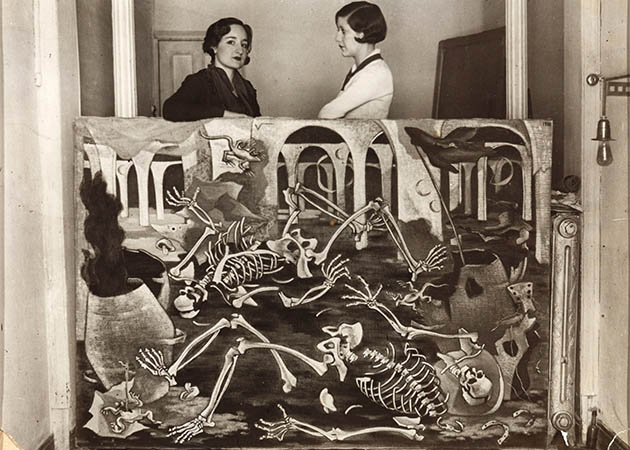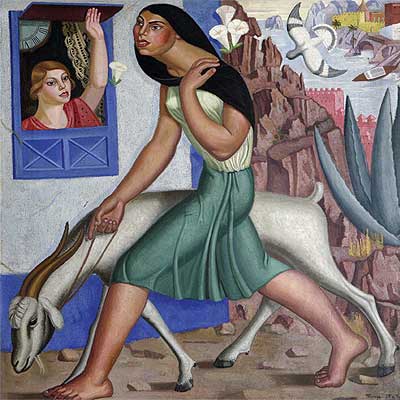Lately I’ve been returning to the art and literature of the Spanish Avant-garde – the time period that sparked my interest in studying Spanish literary, art, and cultural history more in depth (roughly 1917-1930s). Since I received my copy of an edited volume on the Spanish and Italian Avant-garde, Modernism and the Avant-garde Body in Spain and Italy (Routledge 2016) – to which I contributed an article on the 1929 novel La Venus mecánica (The Mechanical Venus) – I’ve been studying the contributions of my colleagues and re-visiting everything I love about this early 20th century era… the chaos, the rejection of tradition, the innovation, the creation of entirely new art forms (surrealism, cubism, futurism, etc.), and, of course, the controversy and scandal that accompanied such aesthetics. Salvador Dalí‘s paintings had always fascinated me, and I’ve written several blog posts about his Christmas cards, landscape inspiration, cookbooks, and public service announcements. Certainly Dalí (along with his renowned contemporaries Luis Buñuel and Federico García Lorca) is one of the most representative figures of Spanish Surrealism; however the historical focus on male artists fails to honor the legacy of the women who began to break through social and cultural barriers by forging non-traditional paths of their own (aka, any role that was not almost exclusively “wife” or “mother”) as artists, poets, and journalists.

Maruja Mallo (left) next to her painting, “Antro de fósiles” [“Fossil Den”], in 1931, alongside Josefina Carabias (right), who is considered Spain’s first full-time female journalist. Image via Ahora (www.ahorasemanal.es).

Image from the documentary, “Maruja Mallo. Mitad ángel, mitad marisco”, produced by TVE (Television española: http://www.rtve.es)
An early sign of her love for masquerade and self-transformation, Maruja Mallo is actually a pseudonym; she was born Ana María Gómez González in 1902 in Viveiro, Galicia, Spain. When her family moved to Madrid in 1922, Mallo studied art and befriended Dalí, who introduced her to Lorca and Buñuel. In fact, in the documentary on her life, “Maruja Mallo. Mitad ángel, mitad marisco,” it is suggested that she embodied the “fourth vertex” of the famous surrealist triangle formed by the artist (Dalí), the poet and playwright (Lorca), and the filmmaker (Buñuel). The title of the documentary is taken from Dalí’s poetically surreal description of his friend: “mitad ángel, mitad marisco” – “half angel, half shellfish.” Shirley Mangini, who has written at length about Mallo, describes this vanguardista as the most noteworthy singularity of the Spanish Avant-garde, given that she embodied the clash between traditional Spanish patriarchy and the emerging “modern woman” (“Madrid” 52). In fact, some of her antics and costumes – throughout her life – rivaled those of Dali’s in terms of “surreality,” absurdity, and scandal.

Maruja Mallo. Image via http://www.rtve.es
Today Mallo’s artwork is on display across Spain, in Paris, and in New York. Madrid’s Reina Sofia Museum houses “La verbena” (The Carnival, or The Street Fair), which is one of a four-part series of oil paintings exhibited in 1928 that was dedicated to capturing the chaotic, surreal, and often subversive atmosphere of Madrid’s open-air festivals. In this post I will discuss these four colorful paintings, particularly with regards to they way in which they defy the expectations and logic of Mallo’s contemporary Spanish society while exposing a multiplicity of sensations and perspectives on topics such as social class, religion, and the female form. I’ll draw much of my commentary from Shirley Mangini’s chapter published in the aforementioned Modernism and the Avant-garde Body in Spain and Italy, entitled “The Gendered Body Politic of Maruja Mallo” (pp. 151-173). Importantly, Mallo’s Verbena scenes contain subtle – and sometimes not-so-subtle – sociocultural criticism and satire. These transgressive elements were key components not only of Mallo’s artistic production and the Avant-garde in general, but of her notoriously iconoclastic personality that shattered taboos and challenged the validity of traditional beliefs, values, and practices. Below is the first Verbena, painted in 1927:

La Verbena (1927). [Image via Reina Sofia Museum, http://www.museoreinasofia.es/coleccion/obra/verbena%5D

“Mujer con cabra” [Woman with goat] by Maruja Mallo, 1929. Image via http://www.elpais.es
In Mallo’s “Verbena de Pascua” (Christmas Carnival) (below), two rather large women are again front and center, though this time they are not the focal point of the painting. Nevertheless, Mangini notes that their movements and appearance defy social mores, as their “corpulent female bodies prominently fill the space with their ungainly strides and short dresses” (159). Their dresses – a bit short for the time – imply that they are maids or servants, thus further placing their liberated public behavior at odds with the expectations of their subservient duties within a private space. The reversal, rejection, or interruption of traditional hierarchical structures, order, and law are key concepts of Carnaval, as Mikhail Bakhtin has pointed out. Curiously, Mallo’s Verbenas visually depict these same notions before they were popularized by Bakhtin, and both Mangini and Urioste point out that Mallo’s paintings are perfect pictorial representations of “el mundo al revés,” or “the world turned upside down”. With law and order suspended in Mallo’s worlds, all social classes and age groups share one public space; opposing concepts of the religious and the profane, high and low culture, and the exceptional and the insignificant coexist, and a parodic new image of contemporary society results (Urioste 205).

Verbena de Pascua (Christmas Carnival), 1929. Image via http://www.leer.es
A fourth festival painting, Verbena Kermesse (below), features a celebration specifically associated with the Church. This particular brightly colored, chaotic atmosphere with a religious basis serves as an excellent illustration of Mallo’s fascination with open-air festivities. Mangini quotes and translates her explanation from Lo popular en la plástica española a través de mi obra (1928-36): “They are a pagan revelation and they express discord with the existing order… On these commemorative dates the street crowds meet. The masses take mythology and the saints as a pretext to enjoy themselves collectively. They feel no veneration for the church whatsoever; rather, they parody celestial order and the demonic hierarchies, masquerading with the elements and attributes of the divine and satanic beings” (158). From this commentary, we might assume that the entire social structure – not merely the dominant Church-State institutions or upper classes – become the objects of Mallo’s subtle critique.
Finally, Fernandez Utrera discusses the possible influence of Salvador Dalí‘s earlier, 1923 rendition of a Spanish Street fair near his rural village of Figueres (Catalonia) – a stark contrast to urban Madrid. While both Mallo’s and Dalí‘s paintings include typical festival attractions like circus performers, games, giant puppets and masqueraders, Fernandez Utrera argues tht the depiction of the “masses”, or the pueblo, is distinct in these artists’ paintings. In Dalí‘s Ferias de la Santa Cruz de Figueres (Santa Cruz Street Fairs in Figueres) (below), individual attendees become lost among the masses, and this homogeneous pueblo – occupying nearly three fourths of the painting’s space – appears in opposition to the marginal circus performers (96). In Mallo’s Verbanas, however, Fernandez Utrera argues that the crowds, the general populace, actually disappears behind the exaggerated, parodic representations of “Official Spain”, and thus becomes secondary within, if not eliminated from, the world Mallo creates (96). In this sense, Fernandez Utrera challenges the so-called subversive nature of Mallo’s Avant-garde Verbenas by suggesting that her position as an artist-intellectual (minority) prevents her from adequately representing the vast majority of the Spanish populace.

Ferias de la Santa Cruz de Figueres (Santa Cruz Street Fairs in Figueres) by Salvador Dali, 1922. Image via http://www.salvador-dali.org
Regardless of the explicit or implicit social critiques of these festival paintings, a comparison of Dalí’s and Mallo’s interpretations provides opportunities for ample discussions on gender, social class, and tradition in the context of Spanish modernity. They would be excellent visuals to use in conjunction with early twentieth-century urban literature from Ramon Gomez de la Serna or Carmen de Burgos, for example. I’m planing to dedicate several upcoming posts to Maruja Mallo and other female writers and artists who are often overlooked or forgotten when it comes to the Avant-garde, or the Spanish vanguardia, and the subsequent Generation of 27. Stay tuned…
What are your favorite paintings or literary texts from the early 20th century Avant-garde movements?
Resources:
Fernandez Utrera, Maria Soledad. “Esencia de verbena: sabor popular y estética de minorías en la pintura de Maruja Mallo.” Revista Canadiense de Estudios Hispanicos 28.1 (2003): 87-102. JSTOR: http://www.jstor.org/stable/27763905
Mangini, Shirley. “The Gendered Body Politic of Maruja Mallo.” Modernism and the Avant-Garde Body in Spain and Italy. New York: Routledge, 2016.
Mangini, Shirley. “Madrid es un Cabaret y Maruja Mallo la protagonista.” Lectures du genre. Numero 11: Genre et caberet: les loisirs nocturnes du corps (2013): 52-65. PDF: http://www.lecturesdugenre.fr/Lectures_du_genre_numero_11/Contenus_files/5.MANGINI.pdf. (Index, Numero 11: http://www.lecturesdugenre.fr/Lectures_du_genre_numero_11/Contenus.html).
Mangini, Shirley. Maruja Mallo and the Spanish Avant-Garde. Farnham, Surrey, England; Burlington, VT: Ashgate, 2010.
Urioste, Carmen. “Violencia discursiva y género: El caso de Maruja Mallo.” Homenaje a la Profesora L. Teresa Valdivieso: Ensayos críticos. Newark, DE: Juan de la Cuesta, 2008. p. 197-209.
Save


















Hola Rebecca,
Maruja Mallo era una excelente pintora, muy vinculada, como resaltas, a la llamada Generación del 27 y a la “vanguardia interior”. Hay una monografía ya antigua sobre ella de Consuelo de la Gándara, publicada por el Ministerio de Educación en 1978. En Galicia en 1992 la Galería Pardo Bazán organizó una exposición de toda su obra gráfica y la Junta de Galicia publicó una voluminosa monografía en 1993. Pero es a partir del 2009 cuando han abundado las retrospectivas y publicaciones. En la base de datos del ISBN aparecen hasta 23 publicaciones registradas.
Aunque hay que tener en cuenta que el registro ISBN se crea en 1972, por lo que para investigar lo que de ella se haya escrito o expuesto antes de esa fecha hay que recurrir a otras fuentes.
Saludos
Ramón
Gracias por las sugerencias bibliográficas, Ramón. Me gustaría consultar uno de esos libros más antiguos, a ver como se compara la perspectiva con la de hoy. Hay varias antologías que he leído últimamente que tratan de Mallo y sus contemporáneas… tengo mucho que leer este año 🙂
Supongo que alguna biblioteca gallega. .. Si me das algún título que te interese pregunto a mis amigos de allá o indago en Madrid en setiembre…
Pingback: Women of the Second Republic (Spain 1931-39) | Rebecca M. Bender, PhD
Pingback: Walking Around Scarecrows and Scarefishes: Surrealist Angst in Maruja Mallo and Pablo Neruda | Rebecca M. Bender, PhD
Pingback: Urban Spain through Literature: Literary Maps of Madrid and Barcelona | Rebecca M. Bender, PhD
Pingback: A New History of Iberian Feminisms (review) | Rebecca M. Bender, PhD
Pingback: Maruja Mallo (1902 –1995) surrealistisch kunstenares – Biancasvisions